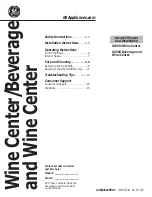
11
0:00
Lift off this cover and connect the
jack plug of the power lead to the
control box behind the front panel
9. Switching on for the first time
"
Check that the inlet / outlet hoses or couplings are properly connected i.e. inlet-to-inlet,
outlet-to-outlet.
"
The by-pass arrangement should be in the open position i.e. the inlet and outlet valves
closed, by-pass valve open. Mains stop valve open.
"
Check that the brine cabinet contains salt.
"
Check that the water softener is connected to the drain and the overflow pipe is
connected. The drain and overflow
must not be linked to each other.
8. Testing for the water hardness in your area
Water hardness can vary from one location to another. To determine the hardness of the
water feeding your water softener (un-softened supply), use the hardness test kit supplied.
"
Fill the test bottle
.
"
Add the tablets to the solution one tablet at a time.
"
Shake the bottle in between and keep adding tablets to the water until the solution turns
from wine red to blue, record the number of tablets as you go.
"
Using the data table supplied with your kit, match up the number of tablets with the
hardness. You will need this figure when programming your water softener in the next
section of this manual.
supplied to the fill line with water from a hard water tap
11
P
RA
T
TWO
"
Gently open the inlet valve so that water flows into the resin vessel.
"
Switch on the power, you will hear the valve move quietly into the start position. When
the positioning process has been completed (which can take up to 10 minutes), you
will hear the movement stop. The valve has now reached its start position in
preparation for the programming procedure.
"
Close the by-pass valve.
"
Gently open the outlet valve.
"
Check for leaks, take corrective action to stop leaks if required.
"
Your water softener is now on line and you may start the valve programming procedure
set out in the next section of this manual.
Now place the water softener salt in the brine cabinet. Use care cubes (tablet salt)
o
Note: Tablet salt or block salt can be used for the WS455 and WS555 models, depending
on preference.
nly, this is available from your local BWT stockist.
Rigid plastic 3/4" overflow pipe (not supplied with the softener) should be connected to
the push fit elbow at the rear of the cabinet (see page 8). Run the pipe downhill to the
outside of the building. Take care that the overflow does not discharge where damage
could occur.
If the water softener is fitted in a cellar or basement, the overflow can be run to a
storage tank. Do not elevate the overflow hose. Do not use jointing cement on the fitting.
4. Overflow connections
5. Electrical connections
For added safety, peace of mind and ease of installation, your water softener is powered
by low voltage via a plug in transformer. This transformer must be connected to a
switched socket. Plug the transformer into the socket with the switch in the OFF position.
10
7. Blending control
6. Filling the brine cabinet, salt usage and the salt alarm
All machines are factory set to produce
water that is soft. If you prefer water which
is less soft, turn the blending knob on the
left side of the valve anti-clockwise until
the water meets your requirements.
Notes on salt usage
Your water softener will only perform effectively if there is salt in the brine cabinet during
the regeneration process. It is therefore essential that the salt level does not fall lower
than 150mm in depth when measured from the base of the brine cabinet.
Note: The softener requires no priming. Do not add water to the brine tank.
During regeneration, salt will not enter your water system as the salt used in the
regeneration process is rinsed safely away to drain.
Your water softener is equipped with a low salt reminder, this monitors your water usage
and sounds an audible alarm whilst displaying the word “SALt”, as a reminder to check
the salt level. To reset the salt alarm, fill the brine tank with salt and press the key
twice.
PAR
T
TWO
WSINST 20pp A5 Seot 2017.indd 11
08/09/2017 08:43






































